 |
 |
 |
| |
Atazanavir/Ritonavir (ATV/r) + Abacavir/Lamivudine (ABC/3TC) in Antiretroviral (ART)-Naïve, HIV-1 Infected, HLA-B*5701 Negative Subjects Demonstrates Efficacy and Safety: the ARIES Trial
|
| |
| |
Reported by Jules Levin
ICAAC/IDSA Oct 27, 2008, Wash DC
K. Squires1, B. Young2, E. DeJesus3, N. Bellos4, D. Murphy5, D. Sutherland-Phillips6, H. Zhao6, L. Patel6, L. Ross6, P. Wannamaker6, M. Shaefer6
1Thomas Jefferson Univ., Philadelphia, PA; 2Univ. of Colorado, Denver, CO; 3Orlando Immunology Ctr., Orlando, FL; 4SW Infectious Disease Assoc., Dallas, TX; 5Clinique Medicale L'Actuel, Montreal, Quebec; 6GSK, RTP, NC, USA
AUTHOR DISCUSSION
Stratified response rates by baseline vRNA (<100,000 and ≥100,000 c/mL) showed apparent differences for the <50 c/mL endpoint. However this difference was not noted for the <200 c/mL or for the <400 c/mL endpoint suggesting that differences in virologic response between strata may have been driven by the inability of some subjects to reach undetectable (<50 c/mL) viral loads by Week 36. As noted previously, approximately 56% of the population enrolled in this study had a baseline vRNA ≥100,000 copies/mL
Utilizing the A5202 VF definition, consistent results, both overall and stratified by baseline viral load (<100,000 and ≥100,000 copies/mL) were noted.
Few treatment-related Grade 2-4 AEs (28%) were observed over 36 weeks with clinical hyperbilirubinemia being the most common (13%) as would be expected with this regimen. Additionally, few subjects discontinued study due to AEs (3%).
AUTHOR CONCLUSIONS
The combination of ATV/r + ABC/3TC demonstrated potent virologic efficacy through 36 weeks of study.
Consistent results were obtained using the A5202 endpoint, regardless of viral load strata.
The rate of protocol-defined virologic failure was low (3%).
Overall, few treatment-related Grade 2-4 AEs (28%) were observed over 36 weeks.
ABSTRACT
Background: Results from ACTG A5202 have raised questions of a higher rate of virologic failure (VF) in subjects on ABC/3TC with a baseline (BL) HIV-1 RNA (vRNA) ≥100,000 c/mL. ARIES was enrolled concurrently with and utilizes the same regimen as one arm of A5202.
Methods: Subjects with screening vRNA ≥1000 c/mL and any CD4+ enrolled in this open-label study of ATV/r + ABC/3TC followed by randomization (1:1) at Week (Wk) 36 to maintain or drop RTV. Study-defined VF was failure to achieve vRNA <400 c/mL by Wk 30 or confirmed rebound ≥400 c/mL.
Additional analysis of A5202 primary efficacy endpoint (vRNA ≥1000 c/mL
at/after Wk 16 and before Wk 24 or confirmed rebound ≥200 c/mL at/after
Wk 24) was conducted.
Results: 515 subjects (ITT-E) included in this non-comparative pre-planned analysis: median age 38; 83% male; 62% white; 13% CDC Class C; vRNA
5.08 log10 c/mL; CD4+ 199 cells/mm3. Drug-related Grade 2-4 clinical AEs
were reported in 142 (28%), most commonly hyperbilirubinemia (13%) and
diarrhea (4%).
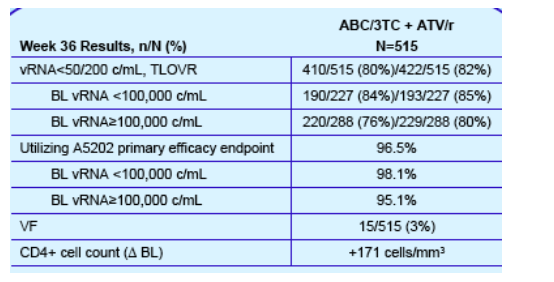
Of 15 cases of VF, 5 and 10 occurred in the <100,000 c/mL and ≥100,000 c/mL
strata, respectively.
Conclusions: The combination of ABC/3TC + ATV/r demonstrated potent
antiviral activity through 36 weeks of follow-up in this population of ART-naïve
subjects. Based on the ACTG A5202 endpoint, similar virologic success rates
were achieved irrespective of VL strata.
INTRODUCTION
ARIES is designed as a treatment strategy study to assess the efficacy and safety of a simplification regimen of abacavir (ABC)/lamivudine (3TC) + atazanavir (ATV) after an induction regimen of ABC/3TC + ATV/ritonavir (RTV, r) in antiretroviral (ART)-naïve patients.
Interim results from the AIDS Clinical Trials Group (ACTG) A5202 have raised questions of an elevated rate of virologic failure (VF) in subjects on ABC/3TC with a baseline (BL) HIV-1 RNA (vRNA) ≥100,000 copies/mL (c/mL).1
ARIES was enrolled concurrently with A5202 and evaluates one of the same regimens (ATV/r + ABC/3TC) used in A5202.
A planned 36 Week interim analysis was performed to assess the efficacy and safety of ATV/r in combination with ABC/3TC in ART-naïve subjects.
METHODS
ARIES subjects were ART-naïve, HIV-1 infected, HLA-B*5701 negative, with plasma vRNA ≥1000 c/mL at the time of screening and no CD4+ cell count restrictions.
The primary endpoint is the proportion of subjects achieving vRNA <50 c/mL at Week 84 by time to loss of virologic response (TLOVR) analysis.
Protocol-specified VF was defined as failure to achieve vRNA <400 c/mL by Week 30 or confirmed rebound ≥400 c/mL after achieving <400 c/mL.
A pre-planned Week 36 non-comparative interim analysis was performed to evaluate efficacy and safety.
An additional analysis utilizing the A5202 VF definition (vRNA ≥1000 c/mL at or after Week 16 and before Week 24 or confirmed rebound ≥200 c/mL at Week 24) was performed to determine the proportion of responders through Week 36 by baseline VL stratification (<100,000 c/mL and ≥100,000 c/mL) .
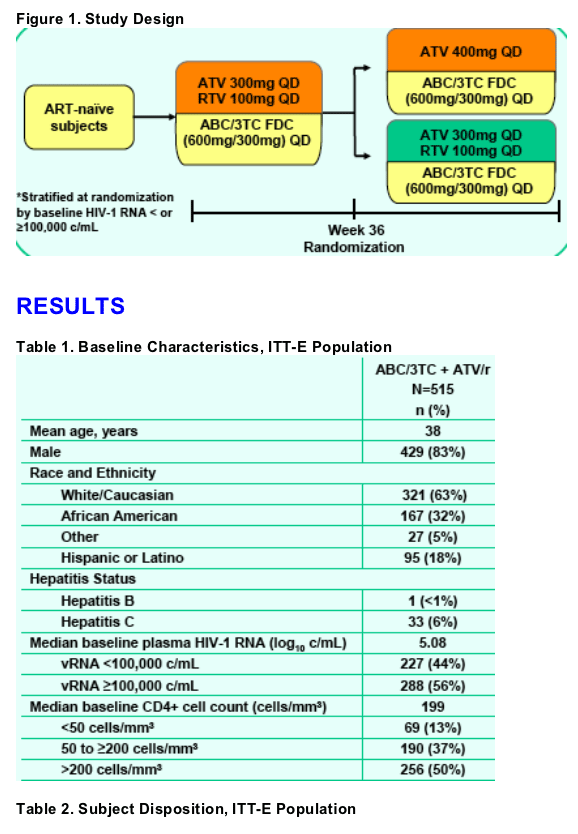
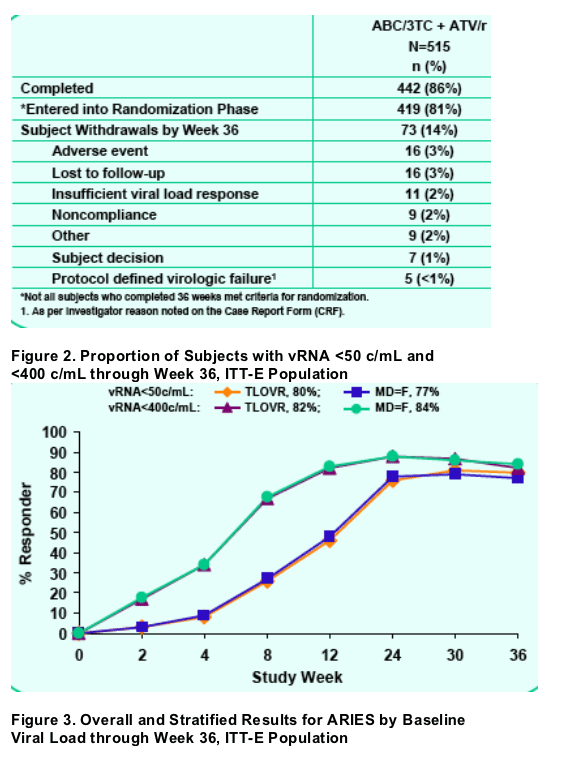
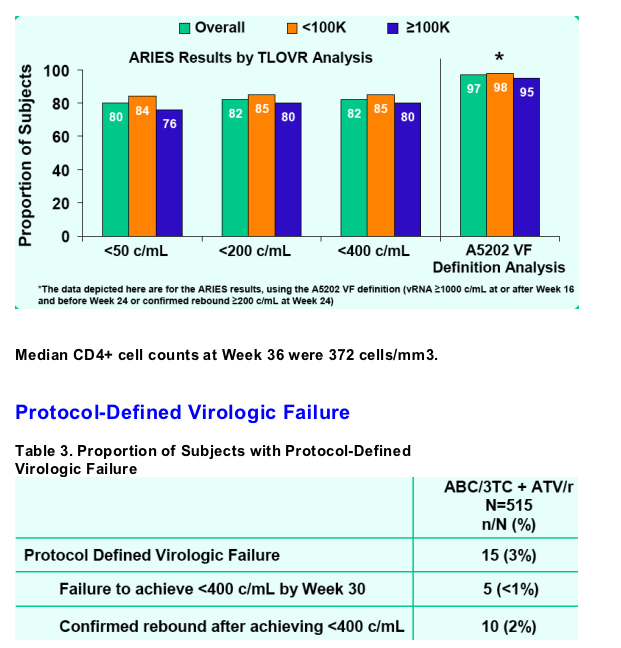
Treatment interruption or non-compliance was reported for 11/15 of the subjects with VF.
No major PI mutations emerged on treatment for subjects meeting VF criteria.
Treatment emergent NRTI mutations (4/15, 27%) were primarily M184I/V or mixes.
14/15 (93%) subjects with VF had viral isolates phenotypically susceptible to all study drugs; isolate in 1 subject exhibited reduced susceptibility to 3TC at time of VF.
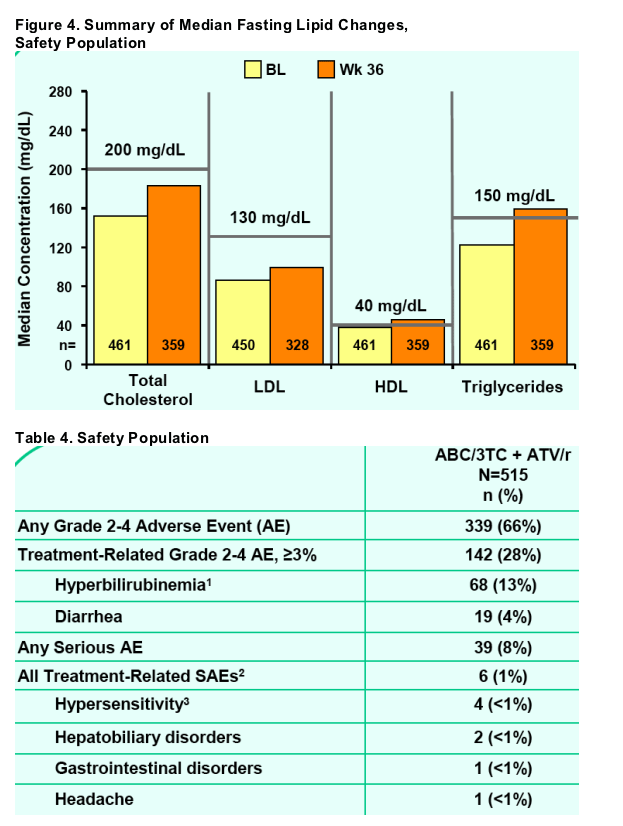
1. Reported as an AE by the investigator. Grade 3-4 hyperbilirubinemia occurring as a lab toxicity, regardless of whether or not it was reported as an AE occurred in 209/511 (41%) of subjects.
2. Subjects could have experienced more than one SAE.
3. The four cases of hypersensitivity were suspected ABC hypersensitivity events.2
*One death (Castleman's disease/hepatic/renal failure) occurred during the study period which was not considered treatment-related by the investigator.
References
1. ACTG 5202. XVII International AIDS Conference 2008. Mexico City, Mexico. Abstract THAB0303.
2. Young, B. et al. AIDS 2008;22:1673.
|
| |
|
 |
 |
|
|